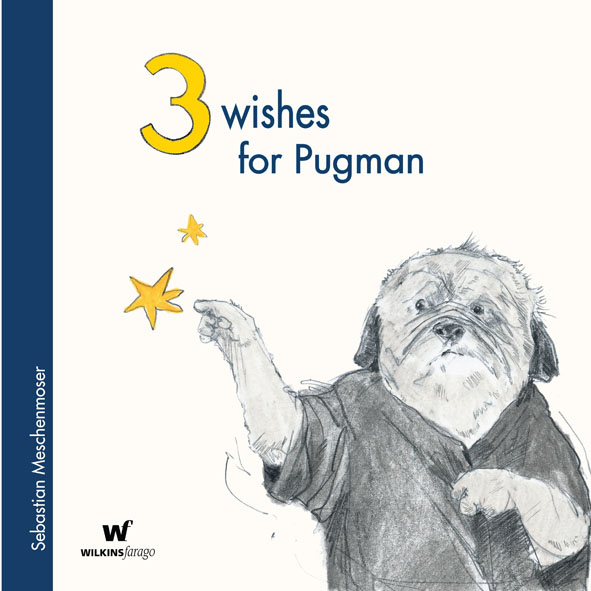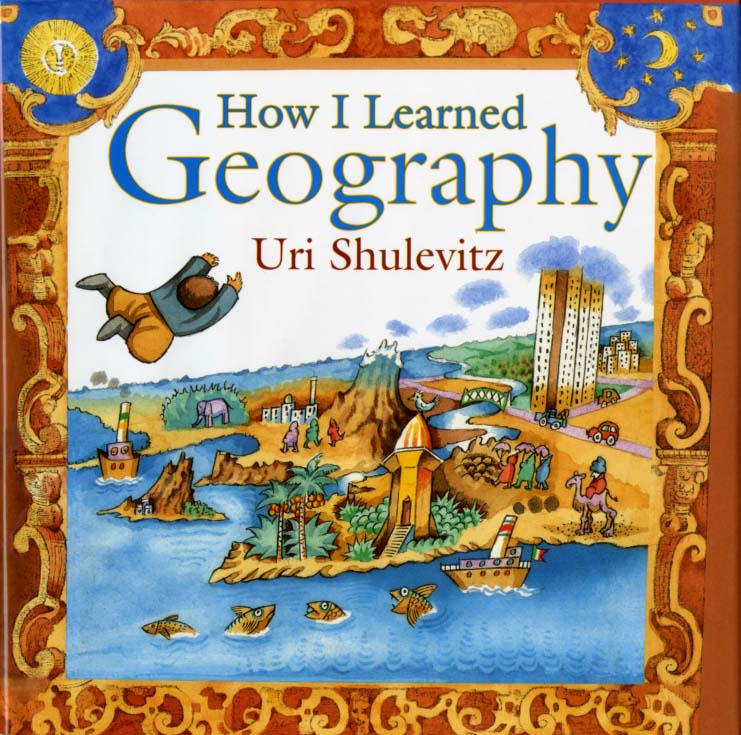
I've been waiting to write about this book in the same way I used to anticipate my birthday as a child: with a giant bubble of joy that quietly sits in the stomach somewhere nudging the heart once in a while, knowing something truly wonderful is out there, does not happen very often, but is entirely real.
3 Wishes for Pugman by the children's-book-writer-illustrator-love-of-my-life S. Meschenmoser is about a depressive dog who lives in a large dog house with a living room and a kitchen and a hallway and art on the walls and other comforts of a nice home. One morning he wakes up at a time of day when one might seriously consider pulling the blankets back over one's head and trying to sleep straight into the next day, but instead he gets up, pulls on his bathrobe, and slowly walks into the kitchen to discover that he is out out of cereal, and coffee, and it's pouring rain outside, and the newspaper is soaked through, and at this point you can probably imagine how he is feeling, especially since he is obviously a PUG and we all know how challenging it is to be one of those in the first place. As Pugman is sitting on the floor contemplating his miserable life, a fairy suddenly appears and offers him three wishes. Whether he takes her up on her offer and what the wishes are if he does, you will really have to find out by reading the book, and I will instead offer my opinions as to why this book is awesome.
First of all, as I had mentioned in my other post where a book by this author was reviewed, there is simply no better artist illustrating children's books at this point in time. Pugman surpasses the level of artistic brilliance set by Learning to Fly; the pencil strokes are looser, more playful, more spontaneous, and convey a new level of mastery. There is also such a world of love for each little pencil stroke and hint of color, and so much kindness in every image that at least for me the book must be read in intervals of a few days because I go into sensory overload from both the visual information and the intense kindness of the narrative and it takes a while to process it all.
Second, similar to Learning to Fly, 3 Wishes for Pugman is a children's book that mercifully does not have any child characters or naive animal characters that children's books are apparently compelled to contain nowadays. Pugman is clearly an adult, with an adult life and adult problems and I think that very fact makes it incredibly valuable for children to read this book - it says that grown up life can be hard and unpredictable too, and does so in a respectful, gentle way. Additionally, when the fairy shows up, she is portrayed in such a vulgar, obscene and invasive way, that the hearts of those of us who hate all the tasteless, Disneyfied, dumbed down, soulless crap that the world of childhood has been infested by, our hearts rejoice and feel validated in a whole new way whether that was the author's intention or not. The super bright colors and the grotesque objects that are paraded by the fairy in an attempt to seduce Pugman into making wishes are in such strong contrast to the depressive, but subtle and tasteful images of the first half of the book that they are hard to look at. I think that by employing a drastic change in the style of the pictures halfway through the book, Meschenmoser makes the strongest commentary on the horrifying reality of children's literature (and, I would argue other forms of child entertainment) to date. Not even Sendak could say it like that, however scathing and sarcastic his remarks were in the last fifteen years or so. However, commentary aside, Meschenmoser seems to possess a Miyazakian quality not to divide his characters into the good and the bad, but to see the wonder, the magic, and potential in every situation, and to make the best of things, which is exactly what Pugman does with his wishes (and, I would say, Meschenmoser with his books).
Before I sign off, as a little bonus, I would like to mention that 3 Wishes for Pugman has a spectacular sequel, that I only have in German, called Mopsmanns Magische Wunderwolle, (or La laine magique de Molosse in French, in which it is also apperently available, though not in English yet, as far as I can tell. Just as, if not even more wonderful than the first one, I recommend getting this in whatever language, the pictures tell the story better than any words ever will.
t
First of all, as I had mentioned in my other post where a book by this author was reviewed, there is simply no better artist illustrating children's books at this point in time. Pugman surpasses the level of artistic brilliance set by Learning to Fly; the pencil strokes are looser, more playful, more spontaneous, and convey a new level of mastery. There is also such a world of love for each little pencil stroke and hint of color, and so much kindness in every image that at least for me the book must be read in intervals of a few days because I go into sensory overload from both the visual information and the intense kindness of the narrative and it takes a while to process it all.
Before I sign off, as a little bonus, I would like to mention that 3 Wishes for Pugman has a spectacular sequel, that I only have in German, called Mopsmanns Magische Wunderwolle, (or La laine magique de Molosse in French, in which it is also apperently available, though not in English yet, as far as I can tell. Just as, if not even more wonderful than the first one, I recommend getting this in whatever language, the pictures tell the story better than any words ever will.
t




 Uri Shulevitz is a hard person for me to write about because he has written and/or illustrated a very large number of books about which I have drastically different opinions, but I'll just focus on this one. I think this is by far the best book Shulevitz has written.
Uri Shulevitz is a hard person for me to write about because he has written and/or illustrated a very large number of books about which I have drastically different opinions, but I'll just focus on this one. I think this is by far the best book Shulevitz has written.